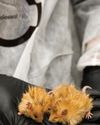Try GOLD - Free
Muse Science Magazine for Kids - Muse July 2025: The Story Behind Wildfires

Holiday Sale
1767430799
Go Unlimited with Magzter GOLD
Read Muse Science Magazine for Kids along with 10,000+ other magazines & newspapers with just one subscription
View CatalogSubscribe only to Muse Science Magazine for Kids
Cancel Anytime.
(No Commitments) ⓘIf you are not happy with the subscription, you can email us at help@magzter.com within 7 days of subscription start date for a full refund. No questions asked - Promise! (Note: Not applicable for single issue purchases)
Digital Subscription
Instant Access ⓘSubscribe now to instantly start reading on the Magzter website, iOS, Android, and Amazon apps.
Verified Secure
payment ⓘMagzter is a verified Stripe merchant.
In this issue
Wildfires such as the devastating Pacific Palisades and Altadena Eaton fires in January are growing in number and destructiveness. How battling climate change, turning to animals, and doing prescribed burns might help.
Muse Science Magazine for Kids Description:
Muse is for kids ages 9-14 who love to learn about new things. Each issue has articles to satisfy every curiosity about our world, from genetics to space to geology. And, Muse is sponsored by the Smithsonian, so your child is always getting up-to-date accurate information.
Recent issues

Muse May-June 2025: Fun by Design

Muse March-April 2025: Everything Is Chemical

Muse February 2025: Waht Misteak?

Muse January 2025: Invisible Kingdom

Muse November-December 2024: Pets on the Mind

Muse October 2024: Afterlives: The end is just the beginning

Muse September 2024: The Art of Data

Muse July-August 2024: Movie Magic

May - June 2024: A Little Help

April 2024

March 2024

February 2024

January 2024

November/December 2023

October 2023

September 2023

July/August 2023

May/June 2023

April 2023

March 2023

January 2023

November/December 2022

October 2022

September 2022

July/August 2022

May/June 2022

April 2022

March 2022

February 2022
Related Titles

Ask Magazine for Kids

Ladybug Magazine for Kids

Cricket Magazine for Kids

Click Magazine for Kids

Spider Magazine for Kids

Cobblestone American History Magazine for Kids

Babybug Magazine for Babies and Toddlers

Faces - The Magazine of People, Places and Cultures for Kids

Magic Logic

Brain Train

ADHDEFG

3D

Foughtism

Chelsea Rhymes

NHEG EdGuide

LIFE : BEARS

Adventures of Bilari and Plim Plim

The Fantastic 400

Heroes

The Dove Who Learned How to Love

The Shark Who Was Scared of the Dark

Creative Steps

The Week Junior Science+Nature UK

Amigo for children

National Geographic Little Kids UK

National Geographic Kids UK/Ireland

Future Genius: The Ocean

The Queen

Future Genius: The Solar System

Wild Canada

































